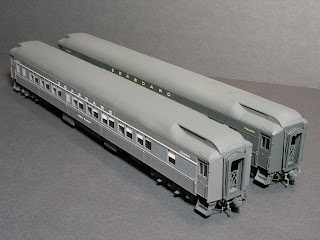One of my favorite passenger cars has always been the Pullman Plan 7600 52 seat coach due to their varied appearance from the premiere Seaboard "Silver" series cars. The cars were originally ordered in 1947 by C&O for the planned Chessie, however, these became surplus and available to other railroads. In June 1958, Seaboard Air Line purchased a lot of 10 coaches for use on secondary trains.
The Plan 7600 series was also ordered by D&RGW (8 cars), NKP (10 cars), and several C&O coaches (1664-1666) were purchased by C&NW in 1957 and numbered as 3483-3485. These were then re-sold in 1961 to Southern Pacific and numbered as 2216-2218. The NKP coaches were sold in part to rival Atlantic Coast Line.
Seaboard Air Line numbered the coaches in the 6242-6251 series which survived in Seaboard's striking light gray, black roof, and black underbody equipment through the 1967 merger. The coaches were unusual due to their partitioned divider within the center of the car which was designed to eliminate the "bowling alley" effect. The cars also retained their partial fluting which stopped below the bottom edge of the windows and retained stainless steel fluting.
Original SAL SCL Serial Number
C&O 1656 SAL 6242 SCL 5254 1377-003
C&O 1657 SAL 6243 SCL 5255 1377-004
C&O 1658 SAL 6244 SCL 5256 1377-005
C&O 1659 SAL 6245 SCL 5257 1377-006
C&O 1660 SAL 6246 SCL 5258 1377-007
C&O 1661 SAL 6247 SCL 5259 1377-008
C&O 1662 SAL 6248 SCL 5260 1377-009
C&O 1663 SAL 6249 SCL 5261 1377-010
C&O 1667 SAL 6250 SCL 5262 1377-011
C&O 1668 SAL 6251 SCL 5263 1377-012
In 1971, all of the cars were conveyed to Amtrak which retained their numbers as AMT 5254-5263.
For years, I have always looked at the Plan 7600 coach with an admiring eye especially due to it's varied appearance, and ultimately in 2013 Walthers released the coach in several paint schemes. Through years of reviewing photographs, I finally located a prototype which matched the Walthers car due to its location of the number board used for car identification. Typically, the number board was centered below the center windows, however, at least one car, SAL 6247/SCL 5259 features the number board offset towards the blind end.
I located a 1967 era image of SCL 5259 at Miami Stadium in Miami, Florida which will serve as the basis for the model. The model will need partial skirt removal, but otherwise is a perfect match for the model. Using the black and white image to color match a model is difficult, however, as luck would have it, I managed to locate an additional image of SCL 5259 in St. Petersburg, Florida in 1970. The color slide offered a chance to view the colors in their natural hues.
The black roof offers a striking difference between the stainless and gray car body. The gray was carried to the ends which were fully painted to match the non-stainless car body.

To prepare the car, I de-constructed the car into various components to include the ends, sides, roof, underbody, and trucks. The car was stripped using 91% Isopropyl Alcohol which removed the silver paint leaving trace amounts. The model will be grit blasted to remove any residual paint and then primed gray to balance the color.
The plastic windows were removed and will be replaced with American Model Builders set 923 acrylic laser cut windows which offer an improved appearance.
The underframe was repainted a flat brown, which will be carried to the trucks, however, several weathering pigments will be applied. The car will be painted with a mixture of Tamiya black for the roof, silver for the stainless steel, and deck tan for the car body.











































